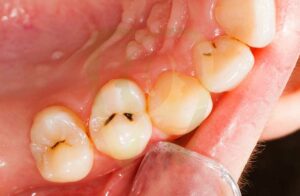Have you ever wondered why your once-healthy teeth are starting to deteriorate from the inside out? The condition known as teeth rotting from the inside out, also referred to as internal tooth decay, can be a concerning and painful issue. In this article, we will delve into the causes, prevention, and treatment of this dental problem, helping you understand how to maintain optimal oral health.
Understanding Internal Tooth Decay
Internal tooth decay occurs when the inner layers of a tooth start to deteriorate, affecting the pulp and nerves. Unlike traditional cavities that develop on the surface of teeth, internal decay can be challenging to detect early on, leading to potential complications if left untreated.
Causes of Teeth Rotting from the Inside Out
Enamel Erosion
The outermost layer of teeth, enamel, acts as a protective barrier. However, excessive consumption of acidic foods and beverages can weaken enamel, making teeth susceptible to decay.
Poor Oral Hygiene Habits
Neglecting proper oral care routines, including irregular brushing and flossing, provides an environment for bacteria to thrive, leading to decay.
Acidic Diet
Frequent intake of sugary and acidic foods creates an environment where harmful bacteria flourish, gradually eroding teeth from the inside.
Dry Mouth Syndrome
Saliva plays a crucial role in neutralizing acids and maintaining oral health. A lack of saliva due to medical conditions or medications can accelerate internal tooth decay.
Signs and Symptoms
Early stages of internal tooth decay may not display noticeable symptoms. As decay progresses, symptoms like sensitivity to hot or cold stimuli, persistent toothache, and discoloration may arise.
The Role of Genetics
Genetic factors can influence an individual’s susceptibility to dental issues, including internal decay. Understanding your genetic predisposition can guide preventive measures.
Preventing Internal Tooth Decay
Maintaining oral health is pivotal in preventing internal tooth decay. Incorporating the following habits can make a significant difference:
Brushing and Flossing Routine
Brushing twice a day and flossing daily helps remove plaque and food particles, reducing the risk of decay.
Balanced and Nutritious Diet
Limiting sugary and acidic foods while consuming a diet rich in calcium and vitamin D strengthens teeth and supports overall oral health.
Regular Dental Check-ups
Professional cleanings and exams every six months aid in identifying and addressing dental issues in their early stages.
Fluoride Treatment
Fluoride strengthens enamel and can be administered through toothpaste, mouthwash, or professional treatments.
Treatment Options
Addressing internal tooth decay promptly is crucial. Common treatment options include:
Dental Fillings
For smaller cavities, dental fillings can restore the tooth’s structure and prevent further decay.
Root Canal Therapy
In cases of advanced decay, a root canal procedure may be necessary to remove infected pulp and save the tooth.
Dental Crowns
Severely decayed teeth may require crowns to restore their shape, strength, and functionality.
Lifestyle Habits and Their Impact
Smoking and Internal Tooth Decay
Smoking not only stains teeth but also weakens enamel, making them vulnerable to decay.
Alcohol Consumption and Dental Health
Excessive alcohol intake can lead to dry mouth, reducing saliva production and increasing the risk of internal tooth decay.
Understanding the Connection with Overall Health
Internal tooth decay can have broader implications for overall health:
Diabetes and Tooth Decay
Uncontrolled diabetes can contribute to dental issues, emphasizing the importance of managing blood sugar levels.
Cardiovascular Health Implications
Emerging research suggests a potential link between oral health and cardiovascular disease, underscoring the significance of dental care.
Maintaining Childhood Dental Health
Instilling proper oral care habits in children sets the foundation for a lifetime of dental health:
Importance of Early Oral Care
Early dental visits and teaching children how to brush properly can prevent future decay.
Limiting Sugary Snacks
Reducing sugary snacks in children’s diets minimizes the risk of decay.
The Psychological Impact
Self-Esteem and Dental Health
Dental issues can impact self-esteem and social interactions. Addressing dental problems promptly is essential for mental well-being.
Overcoming Dental Anxiety
For those with dental anxiety, finding a supportive dentist and practicing relaxation techniques can make dental visits more manageable.
Natural Remedies and Their Effectiveness
Some natural remedies might complement oral care routines:
Oil Pulling
Oil pulling, an ancient practice, involves swishing oil in the mouth to remove bacteria. While not a replacement for brushing, it can be a supplementary step.
Herbal Mouthwashes
Certain herbal mouthwashes can have antibacterial properties that support oral health.
Consulting a Professional
Finding the Right Dentist
Choosing a dentist who understands your needs and concerns fosters a positive dental experience.
Internal tooth decay is a complex issue that demands attention and care. By adopting a proactive approach to oral hygiene, making mindful dietary choices, and seeking timely professional treatment, you can safeguard your teeth from rotting from the inside out. Remember, your dental health significantly impacts your overall well-being.
Why do teeth rot from inside out?
Teeth decay from the inside out due to a process known as dental caries, commonly referred to as cavities. This process is primarily caused by the interaction between bacteria, sugars, and acids in the mouth. Here’s how it generally works:
1. Bacteria: Our mouths contain a variety of bacteria, some of which are naturally present and necessary for digestion. However, certain bacteria, particularly Streptococcus mutans, thrive on sugars from the food we eat. These bacteria form a sticky film called dental plaque on the surface of our teeth.
2. Sugar Consumption: When we consume sugary foods and drinks, the bacteria in our mouths feed on the sugars and produce acids as byproducts. These acids can weaken and demineralize the outer layer of the teeth, called enamel, over time.
3. Enamel Erosion: Enamel is the protective layer of the teeth that helps prevent tooth decay. If the acids produced by bacteria are not neutralized or cleaned away through regular brushing and flossing, they can gradually erode the enamel.
4. Progression of Decay: As the enamel continues to weaken, the decay process progresses deeper into the tooth’s structure. Eventually, it can penetrate the enamel and reach the dentin, the softer tissue beneath the enamel. Dentin is less resistant to decay and is more susceptible to bacterial invasion.
5. Inner Tooth Decay: Once the decay reaches the dentin, it can spread more rapidly due to the softer nature of this tissue. The decay process continues to progress deeper into the tooth, eventually reaching the innermost portion, which contains the pulp. The pulp consists of nerves and blood vessels, and when decay reaches this stage, it can cause pain, sensitivity, and potential infection.
In summary, teeth decay from the inside out due to a combination of bacterial activity, acid production from sugars, and the gradual erosion of the protective enamel layer. Regular dental hygiene practices, such as brushing, flossing, and professional cleanings, help to prevent the buildup of plaque and the progression of decay. It’s important to maintain good oral hygiene and limit sugary foods and drinks to help protect your teeth from the inside-out decay process.
FAQs
1. Is internal tooth decay painful?
Internal tooth decay might not cause pain in its early stages, but as it progresses, you might experience discomfort and sensitivity.
2. Can I reverse internal tooth decay naturally?
While natural remedies can support oral health, advanced decay often requires professional intervention.
3. How often should I visit the dentist?
Regular dental check-ups every




